
Basella alba is an edible perennial vine in the family Basellaceae. It is found in tropical Asia and Africa where it is widely used as a leaf vegetable. It is native to the Indian subcontinent, Southeast Asia and New Guinea. It is reportedly naturalized in China, tropical Africa, Brazil, Belize, Colombia, the West Indies, Fiji and French Polynesia.

Brassica juncea, commonly brown mustard, Chinese mustard, Indian mustard, leaf mustard, Oriental mustard and vegetable mustard, is a species of mustard plant.
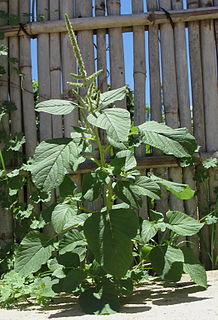
Amaranthus blitum, commonly called purple amaranth or Guernsey pigweed, is an annual plant species in the economically important plant family Amaranthaceae.

Crassocephalum rubens, also called Yoruba bologi, is an erect annual herb growing up to 80 cm tall. It is grown and consumed especially in Southwestern Nigeria, but also as far away as Yemen, South Africa, and islands of the Indian Ocean. Its mucilaginous leaves are used as a dry or fresh vegetable in a variety of dishes, and as medicine for several different ailments.
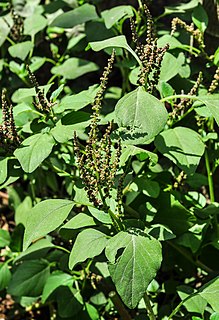
Amaranthus viridis is a cosmopolitan species in the botanical family Amaranthaceae and is commonly known as slender amaranth or green amaranth.
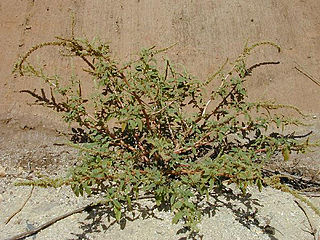
Amaranthus spinosus, commonly known as the spiny amaranth, spiny pigweed, prickly amaranth or thorny amaranth, is a plant is native to the tropical Americas, but is present on most continents as an introduced species and sometimes a noxious weed. It can be a serious weed of rice cultivation in Asia.
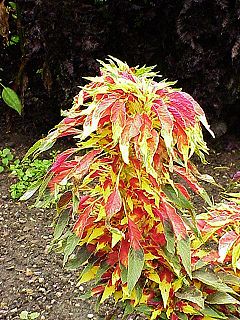
Amaranthus tricolor, known as edible amaranth, is a species of flowering plant in the genus Amaranthus, part of the family Amaranthaceae.
Amaranthus thunbergii, commonly known as Thunberg's amaranthus or Thunberg's pigweed, is found in Africa.

Amaranthus dubius, the red spinach, Chinese spinach,, spleen amaranth, hon-toi-moi, yin choy, hsien tsai, or Arai keerai is a plant species. It belongs to the economically important family Amaranthaceae.

Celosia trigyna is a plant species commonly known as woolflower for its curious flowers.

Asystasia gangetica is a species of plant in the family Acanthaceae. It is commonly known as the Chinese violet, coromandel or creeping foxglove. In South Africa this plant may simply be called asystasia.

Alepidea peduncularis is an edible perennial herb native to the montane grasslands of East and South Africa.
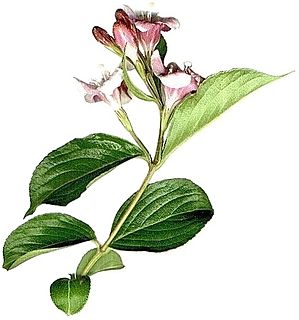
Barleria obtusa, the bush violet, occurs naturally along forest margins in the summer rainfall region of South Africa. It is widely cultivated as a decorative garden shrub.
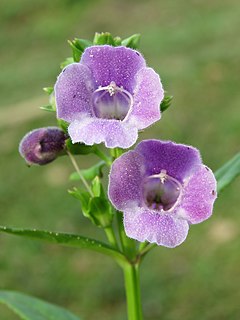
Artanema longifolium is an edible flowering plant species found in tropical Africa, India and South-East Asia. Extracts are used in Ayurveda medicines to treat myositis and nausea. The leaves can also be cooked and eaten as a leafy vegetable. The roots are root used to treat rheumatism, diarrhea, syphilis and ophthalmitis.
Astragalus atropilosulus is a perennial herb in the legume family. It is native to Africa.

The genus Asystasia belongs to the family Acanthaceae and comprises approximately 70 species found in the tropics, including the weedy species Asystasia gangetica.
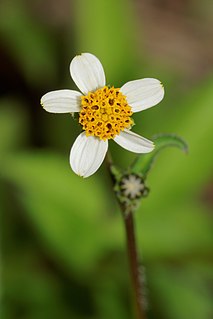
Bidens pilosa is an annual species of herbaceous flowering plant in the daisy family Asteraceae. Its many common names include black-jack, beggarticks, farmer’s friends and Spanish needle, but most commonly referred to as cobblers pegs. It is native to the Americas but is widely distributed as an introduced species in other regions worldwide including Eurasia, Africa, Australia, South America and the Pacific Islands.
Caylusea abyssinica is a plant species found in East Africa.
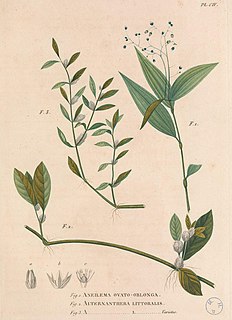
Alternanthera littoralis is an African species of plant in the family Amaranthaceae. The leaves are eaten as a vegetable.
Acalypha ornata is a species in the botanical family Euphorbiaceae. In Africa it is widely used as a medicinal plant. The stems are used as fibres for weaving baskets. The leaves are eaten as a vegetable; the plants are also fed to domestic animals. Acalypha ornata is sometimes planted as an ornamental plant.
















